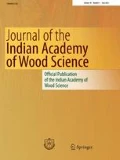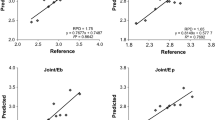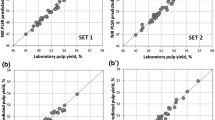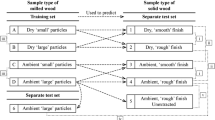Abstract
Near infrared spectroscopy partial least squares (PLS) regression calibrations were developed for estimation of Klason lignin content in Leucaena leucocephala (Lam.) de Wit (commonly called Subabul in India) belonging to the family Fabaceae and sub-family Mimosoideae with solid radial-longitudinal strip and milled samples for trees having diameter ranging from 3.5 to 34.1 cm and age between 4 and 20 years. Samples were conditioned to 10–12 % moisture content. Two separate models were developed for milled samples having particle sizes of 250–400 μm (screened-1) and 420–1,000 μm (screened-2). Regression model using PLS regression with full cross validation were test validated on a separate set of samples. The three multisite calibrations gave RPD (ratio of performance to deviation) between 2.24 and 2.97 with lowest for solid radial strip samples (2.24) and highest for screened-1 powder (2.97). Screened-1 milled sample gave highest r 2p of prediction (0.92) with four factors compared to four that were used for solid strips and eight for screened-2 samples. Model with solid strips gave lowest r 2p of prediction (0.86). Results indicate that properly mixed milled samples having particle size 250–400 μm (screened-1) help in construction of PLS models with higher RPD and less number of factors compared to screened-2 samples (2.48) and solid strips (2.24). Particle size played an important role in construction of the model. Lower RPD with solid strips could be due to variation of chemical constituents from pith to bark. The standard error of calibration (SEC), standard error of cross validation (SECV) and standard error of prediction (SEP) were less than 1 % for Screened-1 samples. For screened-2 samples SEC and SECV were less than 1 % while SEP was 1 %. In case of radial solid strip SEP was slightly above 1 % (1.16) while SEC and SECV were less than 1 %. For constructing models of high accuracy with radial solid strips separate models may be constructed for juvenile and mature wood.



Similar content being viewed by others
References
Anon (1980) In: Proceedings of seminar on Ipil–Ipil organised by FRI, Dehradun, State Forest Department Gujarat and SIDA at Gandhinagar (Gujarat) on 29–30 Dec, pp 1–135
Anon (1981) In: Kaul RN, Gogate MG, Mathur NK (eds) Leucaena leucocephala in India: proceeding of national seminar organised by Ministry of Agricultural, Govt. of India, in collaboration with Maharashtra Forest Department, Bhartiya Agro Industries Foundation (BAIF) and Swedish International Development Agency (SIDA), 26–27 June, pp 1–262
Baillères H, Davrieux F, Ham-Pichavant F (2002) Near infrared analysis as a tool for rapid screening of some major wood characteristics in a Eucalyptus breeding program. Ann For Sci 59:479–490
Bull CR (1991) Compensation for particle size effects in near infrared reflectance. Analyst 116:781–786
Da Silva Perez D, Guillemain A, Alazard P, Plomion C, Rozenberg P, Rodrigues JC, Alves A, Chantre G (2007) Improvement of Pinus pinaster Ait elite trees selection by combining near infrared spectroscopy and genetic tools. Holzforschung 61(6):611–622
Delwiche SR, Reeves JB (2010) A graphical method to evaluate spectral pre-processing in multivariate regression calibrations: Example with Savitzky-Golay regression. Appl Spectrosc 64(1):73–82
Downes GM, Meder R, Hicks C, Ebdon N (2009) Developing and evaluating a multisite and multispecies NIR calibration for the prediction of Kraft pulp yield in eucalyptus. South For 71(2):155–164
Downes GM, Meder R, Ebdon N, Bond H, Evans R, Joyce K, Southerton SG (2010a) Radial variation in cellulose content and Kraft pulp yield in Eucalyptus nitens using near-infrared spectral analysis of air-dry wood surfaces. J Near Infrared Spectrosc 18:147–155
Downes GM, Meder R, Harwood C (2010b) A multi-site, multi-species near infrared calibration for the prediction of cellulose content in eucalypt wood meal. J Near Infrared Spectrosc 18:381–387
Faix O, Bottcher JH (1992) The influence of particle size and concentration in transmission and diffuse reflectance spectroscopy of wood. Holz Roh Werkst 50:221–226
Garbutt DCF, Donkin MJ, Meyer JH (1992) Near infrared reflectance analysis of cellulose and lignin in wood. Pap S Afr 12:45–48
Gierlinger N, Schwanninger M, Wimmer R, Hinterstoisser B, Jacques D, Paques LE (2003) Estimation of extractives, lignin and natural durability of larch heartwood (Larix spp.) by FT-NIR spectroscopy. In: 12th ISWPC, international symposium on wood and pulping chemistry, Madison, USA, 3, pp 51–54
Hein PRG, Lima JT, Chaix G (2010) Effects of sample preparation on NIR spectroscopic estimation of chemical properties of Eucalyptus urophylla S.T. Blake wood. Holzforschung 64:45–54
Hodge GR, Woodbridge WC (2004) Use of near infrared spectroscopy to predict lignin content in tropical and sub-tropical pines. J Near Infrared Spectrosc 12:381–390
Hodge GR, Woodbridge WC (2010) Global near infrared models to predict lignin and cellulose content of pine wood. J Near Infrared Spectrosc 18:367–380
Hu WJ, Harding SA, Lung J, Popko JL, Ralph J, Stokke DD, Tsai CJ, Chiang VL (1999) Repression of lignin biosynthesis promotes cellulose accumulation and growth in transgenic trees. Nat Biotechnol 17:808–812
Huang A, Li G, Fu F, Fei B (2008) Use of visible and near infrared spectroscopy to predict Klason lignin content of bamboo, Chinese Fir, paulowina and poplar. J Wood Chem Technol 28:194–206
Jones PD, Schimleck LR, Peter GF, Daniels RF, Clark A III (2005) Nondestructive estimation of Pinus taeda L. wood properties for samples from a wide range of sites in Georgia. Can J For Res 35:85–92
Jones PD, Schimleck LR, Peter GF, Daniels RF, Clark A III (2006) Non destructive estimation of wood chemical composition of sections of radial wood strips by near infrared spectroscopy. Wood Sci Technol 40:709–720
Jones PD, Schimleck LR, So CL, Clark A III, Daniels RF (2007) High resolution scanning of radial strips cut from increment cores by infrared spectroscopy. IAWA J 28(4):473–484
Kaul RN, Sharma KK (1981) Leucaena leucocephala in India: a review. In: The proceeding of national seminar on Leucaena leucocephala in India, held at Urikanchan, 26–27 June, p 21
Kelley SS, Rials TG, Snell R, Groom LH, Sluiter A (2004) Use of near infrared spectroscopy to measure the chemical and mechanical properties of solid wood. Wood Sci Technol 38:257–276
Kothiyal V, Raturi A (2011) Estimating mechanical properties and specific gravity for five year old Eucalyptus tereticornis having broad moisture content range by NIR spectroscopy. Holzforschung 65(5):757–762
Kothiyal V, Negi YS, Uniyal KK, Panwar PS (2009) Physical and mechanical properties of plantation grown Leucaena leucocephala (Subabul) from Andhra Pradesh & Dehradun. J Indian For 135(8):1026–1038
Kube PD, Raymond CA (2002) Prediction of whole tree basic density and pulp yield using wood core samples in Eucalyptus nitens. Appita J 55:43–48
Kulkarni MM (1980) Leucaena useful tree legume for India. In: Proc., seminar on Ipil–Ipil, organized by Forest Research Institute, Dehradun and State Forest Department, Gujarat and State Industrial Development Authority at Gandinagar, Gujarat, India, p 32
Michell AJ, Schimleck LR (1996) NIR spectroscopy of woods from Eucalyptus globulus. Appita J 49:23–26
Moghimi A, Aghkhani MH, Sazgarnia A, Sarmad M (2010) Vis/NIR spectroscopy and chemometrics for the prediction of soluble solids content and acidity (pH) of kiwifruit. Biosyst Eng 106:295–302
Mora CR, Schimleck LR (2008) On the selection of samples for multivariate regression analysis: application to near-infrared (NIR) calibration models for the prediction of pulp yield in Eucalyptus nitens. Can J For Res 38:2626–2634
Ndlovu ZTL, Swain TL, Zbonak A, Fossey A (2007) Development of a non-destructive near-infrared sampling technique to determine screened pulp yield of Eucalyptus macarthurii. IUFRO, Durban, pp 1–8
Otsuka M (2004) Comparative particle size determination of phenacetin bulk powder by using Kubelka-Munk theory and principal component regression analysis based on near-infrared spectroscopy. Powder Technol 141:244–250
Pande PK, Naithani S, Kothiyal V, Mohanta SS, Juyal N, Rawat R (2008) Intra and Inter tree variations in physico-chemical and wood anatomical properties of Leucaena leucocephala (Lam) DE WIT. J Indian For 134(5):622
Parkinson CE (1923) A forest flora of Andaman Islands. Government Central Press, Simla, p 45
Poke FS, Raymond CA (2006) Predicting extractives, lignin, and cellulose contents using near infrared spectroscopy on solid wood in Eucalyptus globulus. J Wood Chem Technol 26:187–199
Poke FS, Wright JK, Raymond CA (2004) Predicting extractives and lignin contents in Eucalyptus globulus using near infrared reflectance analysis. J Wood Chem Technol 24:55–67
Poke FS, Potts BM, Vaillancourt RE, Raymond CA (2006) Genetic parameters for lignin, extractives and decay in Eucalyptus globulus. Ann For Sci 63:813–821
Ramadevi P, Meder R, Varghese M (2010) Rapid estimation of Kraft pulp yield and lignin in Eucalyptus camaldulensis and Leucaena Leucocephala by diffuse reflectance near-infrared spectroscopy (NIRS). South For 72:107–111
Raymond CA, Schimleck LR (2002) Development of near infrared reflectance analysis calibrations for estimating genetic parameters for cellulose content in Eucalyptus globulus. Can J For Res 32:170–176
Rinnan A, Berg FVD, Engelsen SB (2009) Review of the most common pre-processing techniques for near-infrared spectra. Trend Anal Chem 28(10):1201–1222
Schimleck LR (2008) A rapid, non-destructive method for measuring wood properties and its application to tree breeding. N Z J For Sci 38(1):14–35
Schimleck LR, French J (2002) Application of NIR spectroscopy to clonal Eucalyptus globulus samples covering a narrow range of pulp yield. Appita J 55:149–154
Schimleck LR, Wright PJ, Michell AJ, Wallis AFA (1997) Near Infrared spectra and chemical compositions of E. globulus and E. nitens plantation woods. Appita J 50:40–46
Schimleck LR, Kube PD, Raymond CA (2004) Genetic improvement of kraft pulp yield in Eucalyptus nitens using cellulose content determined by near infrared spectroscopy. Can J For Res 34(11):2363–2370
Schimleck LR, Payne P, Wearne RH (2005) Determination of important pulp properties of hybrid poplar by near infrared spectroscopy. Wood Fiber Sci 37(3):462–471
Schimleck LR, Kube PD, Raymond CA, Michell AJ, French J (2006a) Extending near infrared reflectance (NIR) pulp yield calibrations to new sites and species. J Wood Chem Technol 26:299–311
Schimleck LR, Rezende GDSR, Demuner BJ, Downes GM (2006b) Estimation of whole-tree wood quality traits using near infrared spectra collected from increment cores. Appita J 59:231–236
Schimleck LR, Hodge GR, Woodbridge WC (2010) Toward global calibrations for estimating the wood properties of tropical, sub-tropical and temperate pine species. J Near Infrared Spectrosc 18:355–365
Schwanninger M, Hinterstoisser B, Gradinger C, Messner K, Fackler K (2004) Examination of spruce wood biodegraded by Ceriporiopsis subvermispora using near and mid infrared spectroscopy. J Near Infrared Spectrosc 12(6):397–409
Schwanninger M, Rodrigues JC, Fackler K (2011) A review of band assignments in near infrared spectra of wood and wood components. J Near Infrared Spectrosc 19:287–308
Shukla NK (1982) A preliminary note on strength properties of Leucaena leucocephala from Lalkua, Tarai Bhabar Forest Division (U.P.). J Indian For 108(3):226–229
Shukla NK, Sangal SK (1986) Preliminary studies on strength properties of some exotic timbers. J Indian For 112(5):459–465
Stewart JJ, Kadla JF, Mansfield SD (2006) The influence of lignin chemistry and ultrastructure on the pulping efficiency of clonal aspen (Populus tremuloides Michx.). Holzforschung 60:111–122
Terdwongworakul A, Punsuwan V, Thanapase W, Tsuchikawa S (2005) Rapid assessment of wood chemical properties and pulp yield of Eucalyptus camaldulensis in Thailand tree plantations by near infrared spectroscopy for improving wood selection for high quality pulp. J Wood Sci 51:167–171
Via BK, So CL, Shupe TF, Eckhardt LG, Stine M, Groom LH (2005) Prediction of wood mechanical and chemical properties in the presence and absence of blue stain using two near infrared instruments. J Near Infrared Spectrosc 13:201–212
Williams PC, Sobering DC (1993) Comparison of commercial near infrared transmittance and reflectance instruments for the analysis of whole grains and seeds. J Near Infrared Spectrosc 1:25–32
Wold S (1995) Chemometrics: what do we mean with it, and what do we want from it.? Chemom Intell Lab Syst 30:109–115
Xu L, Zhou YP, Tang LJ, Wu HL, Jiang JH, Shen GL, Yu RQ (2008) Ensemble preprocessing of near-infrared (NIR) spectra for multivariate calibration. Anal Chim Acta 616:138–143
Yamada T, Yeh TF, Chang HM, Li L, Kadla JF, Chiang VL (2006) Rapid analysis of transgenic trees using transmittance near-infrared spectroscopy (NIR). Holzforshung 60:24–28
Yao S, Wu G, Xing M, Zhou S, Pu J (2010) Determination of lignin content in acacia spp. Using near infrared reflectance spectroscopy. BioResources 5(2):556–562
Yeh TF, Chang HM, Kadla JF (2004) Rapid prediction of solid wood lignin content using transmittance near-infrared spectroscopy. J Agric Food Chem 52:1435–1439
Yeh TF, Yamada T, Capanema E, Chang HM, Chiang V, Kadla JF (2005) Rapid screening of wood chemical component variations using transmittance near infrared spectroscopy. J Agric Food Chem 53:3328–3332
Acknowledgments
Authors are thankful to CSIR-NMITLI for providing the financial support for the project and purchase of FT-NIR equipment. Contribution of the project partners from networking Institutes for collecting the samples from Himanchal and Chattisgarh is acknowledged. Staff of the Timber Mechanics Discipline and Wood Working and Finishing Discipline, Forest Products Division, FRI is also acknowledged for sample collection and preparation. Special contribution of Dr. Sachin Gupta and Sh. C. M. Sharma for collection of samples is worth mentioning.
Author information
Authors and Affiliations
Corresponding author
Rights and permissions
About this article
Cite this article
Kothiyal, V., Raturi, A., Kaler, A. et al. Klason lignin estimation in Leucaena leucocephala by near infrared spectroscopy for selection of superior material for pulp and paper. J Indian Acad Wood Sci 9, 105–114 (2012). https://doi.org/10.1007/s13196-012-0078-z
Received:
Accepted:
Published:
Issue Date:
DOI: https://doi.org/10.1007/s13196-012-0078-z




